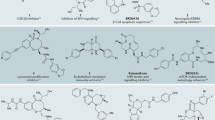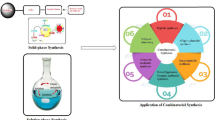Abstract
This article covers the diversity-oriented synthesis (DOS) of small molecules in order to generate a collection of pure compounds that are attractive for lead generation in a phenotypic, high-throughput screening approach useful for chemical genetics and drug discovery programmes. Nature synthesizes a rich structural diversity of small molecules, however, unfortunately, there are some disadvantages with using natural product sources for diverse small-molecule discovery. Nevertheless we have a lot to learn from nature. The efficient chemical synthesis of structural diversity (and complexity) is the aim of DOS. Highlights of this article include a discussion of nature’s and synthetic chemists’ strategies to obtain structural diversity and an analysis of molecular descriptors used to classify compounds. The assessment of how successful one diversity-oriented synthesis is vs another is subjective; therefore we use freely available software (www.cheminformatics.org/diversity) to assess structural diversity in any combinatorial synthesis.
Access this chapter
Tax calculation will be finalised at checkout
Purchases are for personal use only
Preview
Unable to display preview. Download preview PDF.
Similar content being viewed by others
References
Bender A, Mussa HY, Glen RC (2004) Similarity searching of chemical databases using atom environment descriptors (MOLPRINT 2D): evaluation of performance. J Chem Inf Comput Sci 44:1708–1718
Bender A, Glen RC (2004) Molecular similarity: a key technique in molecular informatics. Org Biomol Chem 2:3204–3218
Bohacek RS, McMartin C, Guida WC (1996) The art and practice of structure-based drug design: a molecular modelling perspective. Med Res Rev 16:3–50
Brown RD, Martin YC (1996) Use of structure-activity data to compare structure-based clustering methods and descriptors for use in compound selection. J Chem Inform Comput Sci 36:572–584
Burke MD, Schreiber SL (2004) A planning strategy for diversity-oriented synthesis. Angew Chem Int Ed 43:46–58
Clardy J, Walsh C (2004) Lessons from natural molecules. Nature 432:829–837
Downs GM, Willett P, Fisanick W (1994) Similarity searching and clustering of chemical-structure databases using molecular property data. J Chem Inf Comput Sci 34:1094–1102
Estrada E, Uriarte E (2001) Recent advances on the role of topological indices in drug discovery research. Curr Med Chem 8:1573–1588
Lipinski CA, Lombardo F, Dominy BW, Feeney PJ (1997) Experimental and computational approaches to estimate solubility and permeability in drug discovery and development settings. Adv Drug Deliv Rev 23:3–25
Newman DJ (2003) Natural products as sources of new drugs over the period 1981–2002. J Nat Prod 66:1022–1037
O’Donovan C, Apweiler R, Bairoch A (2001) The human proteomics initiative (HPI). Trends Biotechnol 19:178–181
Oguri H, Schreiber SL (2005) Skeletal diversity via a folding pathway: synthesis of indole alkaloid-like skeletons. Org Lett 7:47–50
Schreiber SL (1998) Chemical genetics resulting from a passion for synthetic organic chemistry. Bioorg Med Chem 6:1127–1152
Schreiber SL (2000) Target-oriented and diversity-oriented organic synthesis in drug discovery. Science 287:1964–1969
Schreiber SL (2003) The small molecule approach to biology. Chem Eng News 81:51–61
Spring DR (2003) Diversity-oriented synthesis; a challenge for synthetic chemists. Org Biomol Chem 1:3867–3870
Willett P, Bernard JM, Downs GM(1998) Chemical similarity searching. JChem Inf Comput Sci 38:983–996
Xue L, Bajorath J (2000) Molecular descriptors in chemoinformatics, computational combinatorial chemistry and virtual screening. Comb Chem High Throughput Screen 3:363–372
Author information
Authors and Affiliations
Editor information
Editors and Affiliations
Rights and permissions
Copyright information
© 2006 Springer-Verlag Berlin Heidelberg
About this paper
Cite this paper
Bender, A. et al. (2006). Diversity Oriented Synthesis: A Challenge for Synthetic Chemists. In: Jaroch, S., Weinmann, H. (eds) Chemical Genomics. Ernst Schering Research Foundation Workshop, vol 58. Springer, Berlin, Heidelberg. https://doi.org/10.1007/978-3-540-37635-4_4
Download citation
DOI: https://doi.org/10.1007/978-3-540-37635-4_4
Publisher Name: Springer, Berlin, Heidelberg
Print ISBN: 978-3-540-27865-8
Online ISBN: 978-3-540-37635-4
eBook Packages: Chemistry and Materials ScienceChemistry and Material Science (R0)




